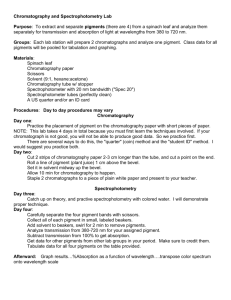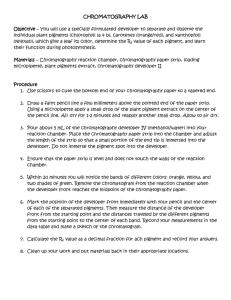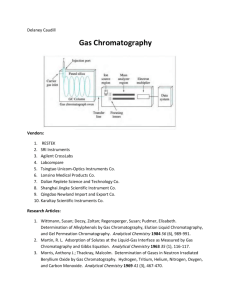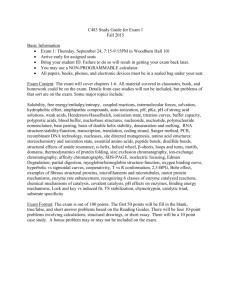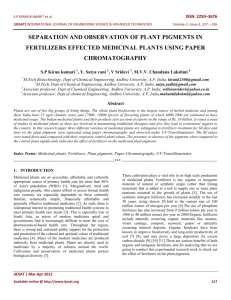lab 17a how do we separate plant pigments
advertisement
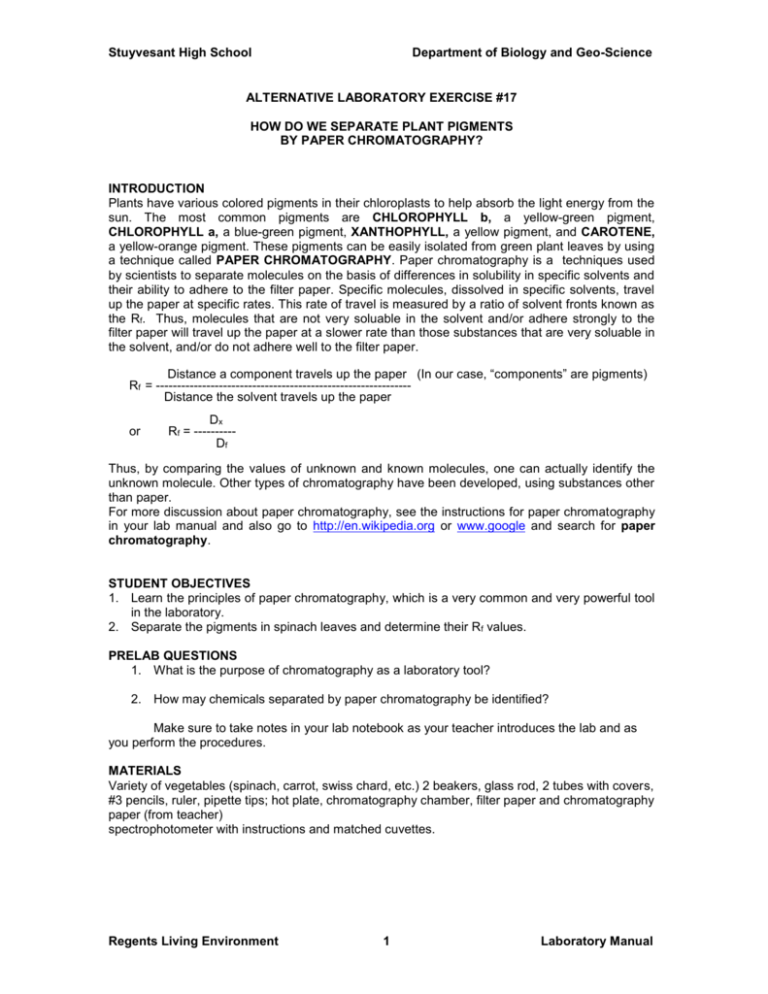
Stuyvesant High School Department of Biology and Geo-Science ALTERNATIVE LABORATORY EXERCISE #17 HOW DO WE SEPARATE PLANT PIGMENTS BY PAPER CHROMATOGRAPHY? INTRODUCTION Plants have various colored pigments in their chloroplasts to help absorb the light energy from the sun. The most common pigments are CHLOROPHYLL b, a yellow-green pigment, CHLOROPHYLL a, a blue-green pigment, XANTHOPHYLL, a yellow pigment, and CAROTENE, a yellow-orange pigment. These pigments can be easily isolated from green plant leaves by using a technique called PAPER CHROMATOGRAPHY. Paper chromatography is a techniques used by scientists to separate molecules on the basis of differences in solubility in specific solvents and their ability to adhere to the filter paper. Specific molecules, dissolved in specific solvents, travel up the paper at specific rates. This rate of travel is measured by a ratio of solvent fronts known as the Rf. Thus, molecules that are not very soluable in the solvent and/or adhere strongly to the filter paper will travel up the paper at a slower rate than those substances that are very soluable in the solvent, and/or do not adhere well to the filter paper. Distance a component travels up the paper (In our case, “components” are pigments) Rf = ------------------------------------------------------------Distance the solvent travels up the paper or Dx Rf = ---------Df Thus, by comparing the values of unknown and known molecules, one can actually identify the unknown molecule. Other types of chromatography have been developed, using substances other than paper. For more discussion about paper chromatography, see the instructions for paper chromatography in your lab manual and also go to http://en.wikipedia.org or www.google and search for paper chromatography. STUDENT OBJECTIVES 1. Learn the principles of paper chromatography, which is a very common and very powerful tool in the laboratory. 2. Separate the pigments in spinach leaves and determine their Rf values. PRELAB QUESTIONS 1. What is the purpose of chromatography as a laboratory tool? 2. How may chemicals separated by paper chromatography be identified? Make sure to take notes in your lab notebook as your teacher introduces the lab and as you perform the procedures. MATERIALS Variety of vegetables (spinach, carrot, swiss chard, etc.) 2 beakers, glass rod, 2 tubes with covers, #3 pencils, ruler, pipette tips; hot plate, chromatography chamber, filter paper and chromatography paper (from teacher) spectrophotometer with instructions and matched cuvettes. Regents Living Environment 1 Laboratory Manual Stuyvesant High School Department of Biology and Geo-Science PROCEDURE I. Extracting the Pigments 1. Each pairs chooses a vegetable for pigment extraction. 2. Add 20 ml isopropyl alcohol to a small beaker. Tear some of the leaves into small pieces and add to beaker. 3. Gently heat at “3” on hot plate for about 5 minutes. Use the glass rod to gently push the leaves under the alcohol. Watch it at all times. When done, carefully remove from heat and cool on the table. II. Preparing the Paper (One of you do this while the extracts are heating) 4. About 2 cm from the long edge, use a #3 pencil to draw a light line along the length of the paper. Starting 5 cm from one edge, make 4 light marks 2 cm apart along this line. Number them 1 through 4. You will apply your samples to these marks. 5. Use a pipette tip to apply a small amount of extract to the paper. Allow it to dry (blow or use the heater fan). Repeat until the spot is fairly dark. (10 or more drops). 6. Divide the remaining pigment in 2 labeled screw capped tubes. Ask the other teams if they want to use your vegetable extract. 7. Repeat with extract from three other vegetable extracts. 8. Record the name of the extracts in your lab book. III. Running the Chromatogram 11. When all the samples have been applied and have dried, curl the paper into a cylinder, overlapping slightly, and staple in the middle. 12. CAUTION! The atmosphere of the chromatography chamber is saturated with the running buffer. You do not want to lose this atmosphere, therefore when you carefully place your rolled up piece of chromatography paper into the chamber Quickly remove the lid, insert the cylinder, and replace the lid. DO NOT MOVE THE CHAMBER. 13. Allow the separation to continue until the buffer front is about 2 cm from the top of the paper. Quickly remove the chromatogram, lightly mark the buffer front immediately with a pencil, and allow it to dry. IV. Analyzing the Chromatogram 14. Prepare a data table that will allow you to record for each extract, the distance that the buffer and each pigment traveled, and allow you to record the calculation of the ratio (R value) between the pigment distances and the buffer distance. 15. When the paper has completely dried, measure (in mm) and record the distance that each pigment from each extract traveled in your chromatogram. 16. Calculate the R value by dividing the distance that each pigment traveled by the distance the buffer traveled. Rpigment = Dpigment/Dsolvent 17. Record these values in your notebook. Compare your data with other pairs of students. Record some of their data so you can discuss them your lab report. V. Spectra of Extracted Pigments 18. Your teacher will demonstrate how to use the spectrophotometer and how to measure the absorbance of pigments in light that ranges from 400nm to 700nm. If time allows, students will be able to work with the spectrophotometer themselves 19. If there is no time available, the data will be given to your for the absorbance of 5 vegetable extracts. Graph this data by hand. Use different colors for the spectrum of different extracts and include a legend on the page. Compare the absorbance spectra of the extracts with each other and to those we have seen in the text. Regents Living Environment 2 Laboratory Manual
